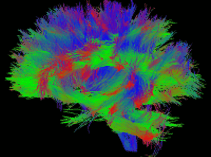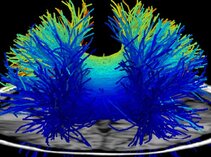Global Tractography
Global tractography aims for holistic reconstruction of dMRI imagery in human brain white matter. Contrarily to the common sequential, stepwise approach, fibers and orientation distributions are reconstructed simultaniously by a process reminiscent to a polymerization process.
Gibbs Tracking
In this project we suggest a new realization of global tractography with the focus on model simplicity and computational performance. The basic idea shares some properties with other recent global tracking algorithms (Mangin, 2002; Kreher et al., 2008; Fillard et al., 2009): The reconstructed fibers are built with small line segments, which bind together during the optimization. Their orientation and number are adjusted simultaneously to match the data. This behavior is governed by an interaction between line elements and by an increasing match to the measured data. The proposed approach won the MICCAI fibercup in 2009. The algorithm can be dowloaded here, where it is integrated in our in-house diffusion toolbox. The algorithm is also available for mrtrix (Daan’n multi-tissue extension) and MITK.
- Christiaens, Daan and Reisert, Marco and Dhollander, Thijs and Sunaert, Stefan and Suetens, Paul and Maes, Frederik
“Global tractography of multi-shell diffusion-weighted imaging data using a multi-tissue model”
Neuroimage, vol 123, pp 89-101, 2015, Elsevier - Pierre Fillard, Maxime Descoteaux, Alvina Goh, Sylvain Gouttard, Ben Jeurissen, James Malcolm, Alonso Ramirez-Manzanares, Marco Reisert, Ken Sakaie, Fatima Tensaouti, Ting Yo; Jean-François Mangin, Cyril Poupon
“Quantitative Analysis of 10 Tractography Algorithms on a Realistic Diffusion MR Phantom”
Neuroimage, 56(1):220-34, 2011 2010 - Peter F. Neher, Bram Stieltjes, Marco Reisert, Ignaz Reicht, Hans-Peter Meinzer and Klaus H. Fritzsche
“MITK Global Tractography – Application to the Corticospinal Tract.”
In Proceedings of the MICCAI 2011, Workshop: DTI Tractography for Neurosurgical Planning: A Grand Challenge, Toronto, Canada - M.Reisert, I. Mader, C. Anastosoulus; M. Weigel, S. Schnell; V.Kiselev,
“Global Fiber Reconstruction Becomes Practical”
Neuroimage. 2011 Jan 15;54(2):955-62. doi: 10.1016/j.neuroimage.2010.09.016. Epub 2010 Sep 18.
Mesoscopic Tractography
Mesoscopic brain tissue modeling attempts to quantify cellular-level tissue organization in each voxel. However, determining the μm-scale parameters, such as axonal dimensions, water fraction and myelin thickness from a dMRI signal acquired at a 100–1000 times lower resolution, is a difficult problem riddled by unstable model fitting and sensitivity to noise. Fiber tractography, on the other hand, focuses on characterizing the structural connectome and inferring the interregional relationships of the human brain. It delineates white matter tracts based on the empirical anisotropy of the dMRI signal, and does not attempt to quantify the mesoscopic structure. In this project we try merge both fields into one framework such that both problems can benefit from each other. The proposed algorithm performs a global tracking and local modeling simultanously.
- D. Novikov, V. Kiselev and M. Reisert
“SYSTEM, METHOD AND COMPUTER-ACCESSIBLE MEDIUM FOR OBTAINING AND/OR DETERMINING MESOSCOPIC STRUCTURE AND ORIENTATION WITH FIBER TRACKING”
United States Patent Application 20160042508 - M. Reisert, V.G. Kiselev, B. Dihtal, E. Kellner, D.S. Novikov
“MesoFT: Unifying Diffusion Modelling and Fiber Tracking”
Medical Image Computing and Computer-Assisted Intervention – MICCAI 2014, Springer LNCS, Volume 8675, 2014, pp 201-208

The algorithm estimates fiber tracts as well as fiber diffusion properties (indicated by the color coding)
Modelfree Tractography
It is usually assumed that the dMRI signal is a convolution of a fiber specific response function (FRF) with a fiber orientation distribution (FOD). The FOD is the focus of tractography. While in the past the FRF was estimated beforehand and was usually assumed to be fix, more recent approaches estimate the response function during tractography. This project investigates novel objective functions independent of the FRF, just aiming for FOD reconstruction.

Segment densities are driven by voxel complexity. In this way, a known artefcats from Gibbs tracking can be suppressed: much less fibers are ending artifically in white matter.

The analysis of connectivity matrices show that modelfree tractography can improve retest reliability and hence leads to a robust biomarker.
Funding Sources
- BW-Stiftung: Eliteprogramm für Postdoktorandinnen und Postdoktoranden, “Ein globales Strukturmodell des Gehirns”.
- Deutsche Forschungsgemeinschaft DFG KI 1089/3-1
- Deutsche Forschungsgemeinschaft DFG KI 1089/3-2
Dr. Marco Reisert
Group Leader
Tel.: +49 761 270-93860
E-Mail: marco.reisert@uniklinik-freiburg.de
University Medical Center Freiburg
Dept. of Radiology · Medical Physics
Killianstr. 5a
79106 Freiburg





